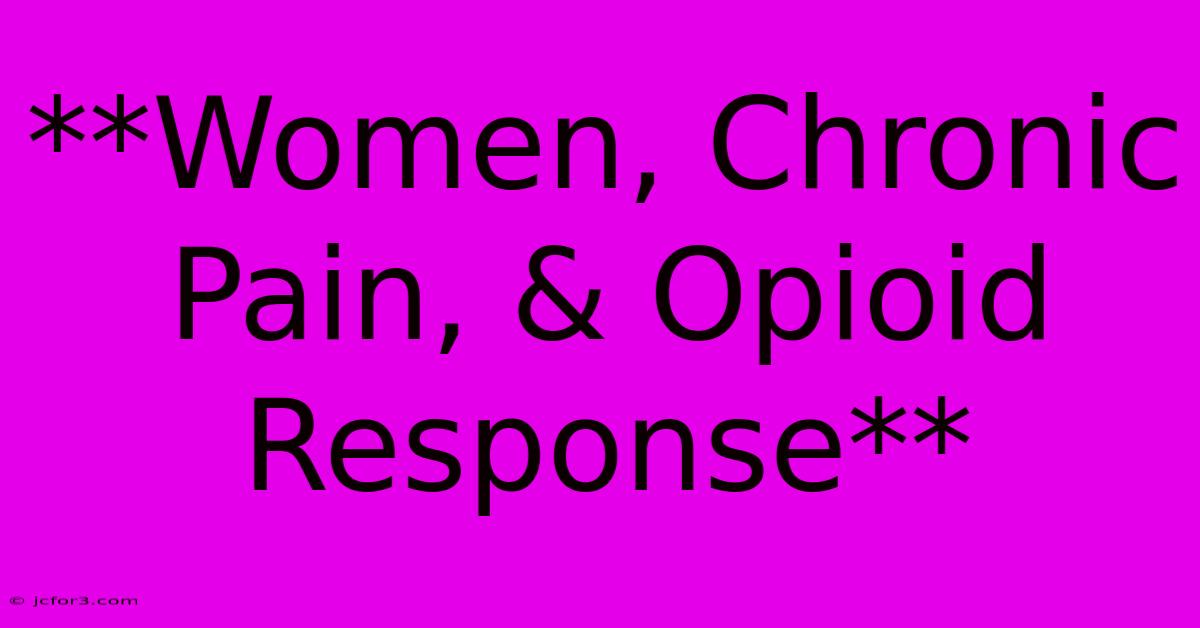**Women, Chronic Pain, & Opioid Response**

Discover more detailed and exciting information on our website. Click the link below to start your adventure: Visit Best Website mr.cleine.com. Don't miss out!
Table of Contents
Women, Chronic Pain, & Opioid Response: A Complex Relationship
Chronic pain is a debilitating condition that affects millions of people worldwide, and women are disproportionately impacted. This article explores the unique challenges women face when managing chronic pain, including their often-different response to opioid medications. Understanding these complexities is crucial for providing effective and personalized pain management.
The Gender Gap in Chronic Pain
Studies consistently show that women experience chronic pain at significantly higher rates than men. This disparity can be attributed to several factors, including:
- Biological Differences: Women's hormonal cycles, pregnancy, and menopause can influence pain perception and sensitivity.
- Social and Cultural Factors: Societal expectations and gender roles can lead women to underreport pain or seek medical attention later.
- Diagnosis and Treatment: There is a historical tendency for healthcare providers to dismiss women's pain complaints, leading to delayed or inadequate treatment.
Opioids and Women: A Complicated Picture
Opioids are a class of medications commonly prescribed for pain relief, but their use in women with chronic pain presents several unique challenges:
- Higher Risk of Side Effects: Women may be more susceptible to opioid-related side effects like nausea, constipation, and mood changes.
- Increased Risk of Dependence and Addiction: While addiction is a concern for anyone using opioids, women may be at a higher risk due to factors like hormonal fluctuations and pre-existing mental health conditions.
- Pregnancy and Breastfeeding: The use of opioids during pregnancy and breastfeeding can pose risks to both mother and child.
The Need for Personalized Pain Management
The complex interplay of biological, social, and medical factors necessitates a personalized approach to pain management for women. Here are some key considerations:
- Comprehensive Assessment: A thorough medical history, physical examination, and mental health evaluation are crucial to understand the individual's pain experience.
- Non-Opioid Treatment Options: Non-pharmacological approaches such as physical therapy, acupuncture, and cognitive-behavioral therapy should be explored as first-line treatments.
- Opioid Prescribing with Caution: If opioids are necessary, they should be prescribed cautiously with careful monitoring and risk assessment.
- Multidisciplinary Care: Collaboration between pain specialists, primary care physicians, mental health professionals, and other relevant healthcare providers is vital.
Empowering Women: Taking Control of Pain Management
Women play a crucial role in advocating for their own health. Here are some tips for navigating chronic pain management:
- Communicate openly and honestly with your healthcare providers. Describe your symptoms in detail and express your concerns.
- Educate yourself about pain management options. Research non-opioid alternatives and explore different approaches.
- Consider joining a support group. Connecting with others who understand your experience can provide valuable support and resources.
- Prioritize self-care. Engage in activities that promote physical and mental well-being, such as exercise, relaxation techniques, and healthy eating habits.
Looking Ahead: Research and Advocacy
Further research is needed to understand the unique needs of women with chronic pain. Advocacy efforts are essential to ensure that women's voices are heard and their pain is taken seriously. By raising awareness, promoting research, and advocating for equitable access to care, we can work towards improving the lives of women living with chronic pain.
Keywords: chronic pain, women's health, opioid response, pain management, non-opioid treatment, personalized care, addiction, gender disparities, healthcare access, advocacy, research.

Thank you for visiting our website wich cover about **Women, Chronic Pain, & Opioid Response**. We hope the information provided has been useful to you. Feel free to contact us if you have any questions or need further assistance. See you next time and dont miss to bookmark.
Featured Posts
-
Champions League 2024 Barcelona Vs Bayern Highlights
Oct 24, 2024
-
Turkish Airstrikes Hit Iraq Syria Following Attacks
Oct 24, 2024
-
Tesla Cuts Costs Profits Soar In Q4
Oct 24, 2024
-
Brandon Millers Hip Injury Early Exit
Oct 24, 2024
-
Bahceli Nin Cagrisi Karayilan Tusas Saldirisini Yorumladi
Oct 24, 2024
